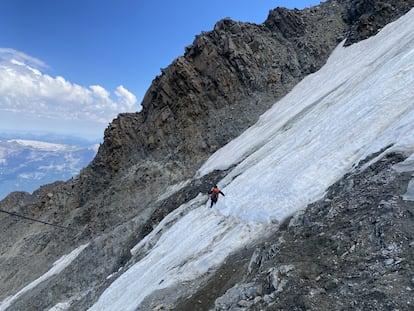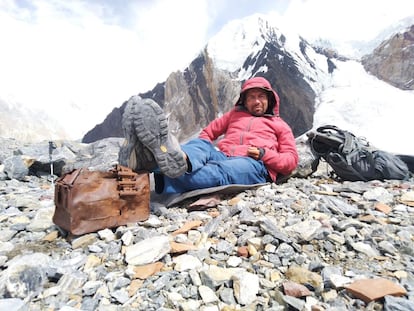The dangers of ascending Mont Blanc as laid out by science
A study by the University Savoie Mont Blanc has measured the fall of rocks and ice masses on the two most frequented routes to the roof of Europe, thus delimiting the main objective risks into two black spots
Last summer, ranger Antoine Rattin returned to the Goûter refuge, an almost obligatory stop on the way to the summit of Mont Blanc (4,808 meters), with a broken arm in a sling and a nasty gash on his face near his temple. Nobody was surprised when he explained how he had come about the injuries: “It was on the Grand Couloir ...” In fact, he had been born again. Mountain guides and most Spanish mountaineers know this place as “la bolera” (the bowling alley), a horizontal passage barely 100 meters long that is one of the massif’s black spots. Crossing this corridor involves exposing oneself to a somewhat maddening game in which climbers must avoid being dragged along or killed by the rocks rolling down the slope. Hit by a medium-sized boulder, Rattin was thrown about 15 meters down the slope but was able to halt his fall. The less fortunate are picked up by rescue helicopter hundreds of meters farther down and taken to the morgue. Between June 15 and September 15, at the height of the season, an average of 21,350 people have crossed that point since 2017, yielding an annual average of 3.7 fatal accidents. Rattin passes the fateful spot many times each summer, as do many high-altitude guides, who put their clients on a short rope and invest a few seconds in crossing from one safe zone to another. These are the tensest seconds of the entire climb and have to be repeated on the return from the summit.
These statistics come from a study by the University Savoie Mont Blanc, which for the first time has made it possible not only to analyze the risks taken by mountaineers on the two most frequented routes, but also to quantify them. There are two main types of danger in the mountains: objective and subjective. The latter are triggered by the actions and decisions of mountaineers, as well as any errors (logistical, knowledge, physical preparation, overestimation of their ability, poor equipment, etc.) that they may make. Objective hazards refer to the terrain and, although it is possible to prevent their impact to a certain extent, it is a risk to be assumed when practicing any type of mountain activity: rock falls, snow avalanches, storms, lightning, glacier crevasses... In an unprecedented study, the researchers have delimited in the most precise way possible a key question: what exactly are we talking about when we talk about objective hazards on the normal routes on Mont Blanc?
The most popular route to the summit of Mont Blanc is the Voie Royale, also known as the Goûter Route and includes a stop at the refuge. The second, known as the Trois Monts, crosses the slopes of Mont Blanc du Tacul and Mont Maudit before reaching the roof of the Alps. The objective dangers that lie in wait for climbers on both routes are quite different in nature. Thermal conditions have a direct influence on the frequency and quantity of rock falls from the bowling alley, while they have no effect whatsoever on the collapse of seracs (ice masses) that threaten those passing along the north-northwest slope of Mont Blanc du Tacul. In the latter scenario, seracs can fall at any time, whereas in the bowling alley, less dangerous time slots can be pinpointed: between 2 a.m. and 12 noon, there is the lowest level of rockfall, and particularly between 9 a.m. and 10 a.m. Activity increases thereafter, reaching a critical point between 6 p.m. and 7 p.m. This information is crucial to allow climbers to reduce their exposure to risk. This is not the case on the north-northwest slope of Tacul, where it is very difficult to anticipate the fall of a serac and only a careful reading of the terrain to pinpoint highly fractured ice masses or small ice falls can provide clues when choosing the route to follow.

On the Tacul slopes, the average number of fatal accidents per year is 0.6, and the risk is twice as high as on the Voie Royale. However, climbers spend much more time exposed to the potential danger of the Tacul (hours in some cases), while on the route that passes through Goûter the passage through the bowling alley is carried out in just half a minute (for a fast roped team). However, many more climbers pass through the latter point, where, additionally, the frequency of rockfall is much higher. The scientists who carried out the study point to the bowling alley as the most dangerous place in the Alps and one of the most perilous on the planet.
In order to measure the frequency of rock falls at that point, a seismic device and a sensor were installed in 2019 that monitored the influx of mountaineers. Between 2016 and 2020, fixed photographic cameras collected all serac falls on the Tacul as well as the volume of mountaineers. In the case of the bowling alley, a revealing fact was recorded: a major rockfall occurred every 37 minutes, and the size of these grew towards the end of the summer season. The researchers point out that there is a classification of risks: those that society tolerates are defined as “acceptable risks” and it is not worth investing in reducing them. On the other hand, “tolerable risks” are those society can live with and extract a certain benefit from, while trying to reduce their threat (driving, or mountaineering, for example). The dangers posed by the bowling alley are three times higher than road mortality in France, which means that an average mountaineer is as likely to die in a single crossing as to do so from driving a car normally for three years. Yet, for a 45-year-old French climber, passing through the bowling alley raises the chances of death to 10 times higher than the normal probability of dying. On the other hand, if a 15-year-old were to pass through the bowling alley, they would be twice as likely to die as a 45-year-old professional mountaineer or mountain guide who crosses through the same point 10 times a year.
Scientists point out that the conditions and the danger of both scenarios on Mont Blanc will worsen in the future: the permafrost (the permanently frozen ground layer) on the west face of the Aiguille de Goûter is deteriorating every year, and this degradation will accelerate. The warming of the Tacul ice could speed up its cracking and the collapse of ice masses. It will then be necessary to review the reality of its objective dangers.
Sign up for our weekly newsletter to get more English-language news coverage from EL PAÍS USA Edition
Tu suscripción se está usando en otro dispositivo
¿Quieres añadir otro usuario a tu suscripción?
Si continúas leyendo en este dispositivo, no se podrá leer en el otro.
FlechaTu suscripción se está usando en otro dispositivo y solo puedes acceder a EL PAÍS desde un dispositivo a la vez.
Si quieres compartir tu cuenta, cambia tu suscripción a la modalidad Premium, así podrás añadir otro usuario. Cada uno accederá con su propia cuenta de email, lo que os permitirá personalizar vuestra experiencia en EL PAÍS.
En el caso de no saber quién está usando tu cuenta, te recomendamos cambiar tu contraseña aquí.
Si decides continuar compartiendo tu cuenta, este mensaje se mostrará en tu dispositivo y en el de la otra persona que está usando tu cuenta de forma indefinida, afectando a tu experiencia de lectura. Puedes consultar aquí los términos y condiciones de la suscripción digital.








































